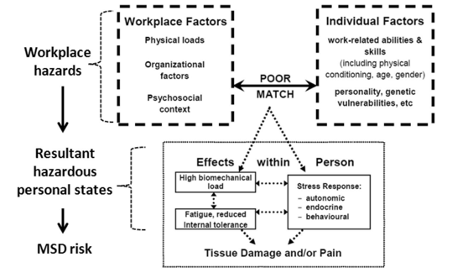A primary role of Workplace Health and Safety teams across the world is dealing with musculoskeletal disorders (MSDs) arising within the workplace. MSDs include a wide range of inflammatory and degenerative conditions affecting the muscles, tendons, ligaments, joints, nerves, and supporting blood vessels.
Work-related MSDs (WMSDs) continue to be one of the biggest occupational health and safety problems across the world. In Australia, there are some alarming numbers associated with the burden of WMSDs:
- The annual costs are calculated to be over $24 billion
- The time lost from work for serious WMSD claims increased by 35% from 2000-01 to 2012-13
- Between 2009-2014, 60% of serious workers’ compensation claims were for WMSDs
One reason for this ongoing problem is that workplace risk management strategies do not meet the requirements needed for effective evidence-based risk management. Currently, strategies fail to address the risks posed by psychosocial hazards, they don’t allow the right amount of participation from workers, and often fail to control the risk at the source.
The below diagram outlines the risk factors associated with WMSDs.
How can we bridge this gap?
Jodi Oakman and Wendy Macdonald have developed A Participative Hazard Identification and Risk Management (APHIRM) Toolkit that is evidence-based and intended to be used by those responsible for occupational health and safety in their workplace. The development of the tool was completed in accordance with a framework developed by the World Health Organisation, as well as scientific principles.
The research to develop the APHIRM Toolkit was focussed on addressing 3 major gaps when it comes to the evidence being used in practice:
- Workplace practices focusing on physical hazards, generally failing to address psychosocial hazards
- Risk management being more effective when workers are actively involved
- Risk control is most effective when it addresses the risk at its source.
The toolkit procedure involves 6 straightforward steps which can be followed for effective risk management. In essence, the toolkit is used to assess the level of risk for possible hazards, formulate action plans, implementation of plans, and review effectiveness of implemented strategies.
“But we already do risk assessments at my workplace.”
The current incidence of workplace MSDs is unlikely to reduce significantly unless workplace practices undergo substantial change. The APHIRM toolkit provides a strategy to bridge gaps for this change to occur. Workplaces can use a set of online tools provided, for automated data analysis and reporting guidelines, and importantly as guidance to support workplace managers at all stages of the risk management cycle.
Currently, the usual focus of standard risk assessment tools is on the physical risk. The APHIRM toolkit recognises and enables the management of MSD risk from psychosocial hazards as well as from physical hazards. This enables a more holistic approach to risk management, which has been identified as necessary for effective risk control. It is not possible to assess psychosocial risk factors without the workers’ input, as this will be influenced by their personal perceptions. Using the tool to increase active engagement from workers themselves will allow for more effective risk reduction in the workplace.
What next?
An APHIRM toolkit website (www.aphirm.org.au) has been established to provide access to the toolkit and online resources for workplace practitioners. It is now available for trialling on the condition that users complete an initial one-day training course.
Sometimes this task can appear overwhelming, but by ensuring purposeful and incremental steps are made towards a larger goal of a company’s risk management strategy, this task will assist in enacting positive workplace change. Ultimately, this toolkit is a piece of the overall puzzle for risk management. To have a comprehensive strategy in place, contact the Employ Health team to see what approach is best for a safer and more productive workforce.
References
Safe Work Australia. The cost of work-related Injury and illness for Australian employers, workers and the community: 2012–13. 2015. http://www. safeworkaustralia.gov.au/sites/swa/about/publications/pages/cost-injuryillness-2012-13.
Bevan, S. (2015). Economic impact of musculoskeletal disorders (MSDs) on work in Europe. Best Practice & Research Clinical Rheumatology, 29(3), 356-373.
Punnett, L., & Wegman, D. H. (2004). Work-related musculoskeletal disorders: the epidemiologic evidence and the debate. Journal of electromyography and kinesiology, 14(1), 13-23.














